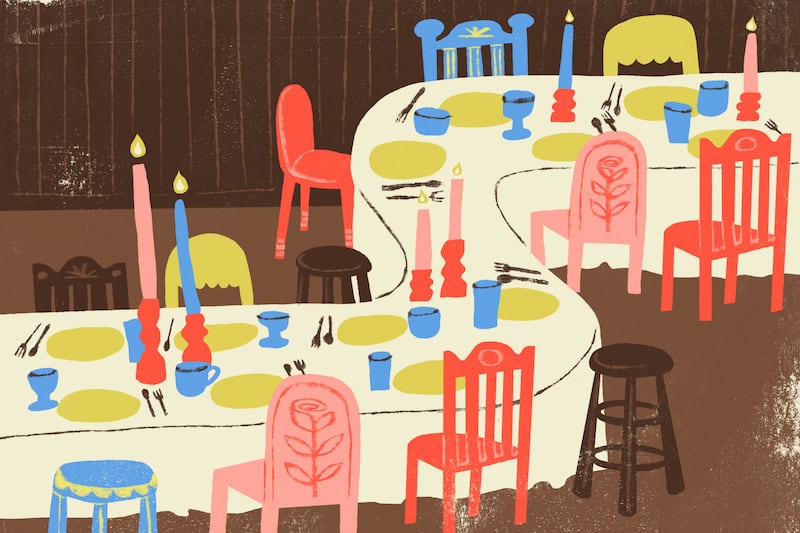For much of my adult life, I’ve been a guest at Christmastime, graciously adopted into the holiday gatherings of other families. As a college student in Utah, with my family in Ukraine, I faced the same question every year: Where will I spend Christmas break when all my friends go home? Traveling home was too far and too expensive, and no one in my immediate family lived in the states. My father’s cousin, who lived in Oregon, often welcomed me for the Christmas break. Other times, I would join a roommate’s family for their celebrations. While my hosts welcomed me with warmth and generosity, I often felt like an awkward outsider stepping into the established and unfamiliar order of another family’s traditions, habits and history.
Getting married brought some resolution to the holiday dilemma. I had a new family to join, without the unease I’d felt before. My in-laws lived in Utah and my husband’s four siblings often gathered in their home for the holidays. Those holiday gatherings were loud, fun and memorable. As an only child, I felt immersed in the chaos, and the love, of this big family. But after settling in Boston and having children, the frequency of our trips to Utah went down as the number of children went up and the trips became more logistically challenging and financially prohibitive. I’ve enjoyed our smaller and quieter celebrations, but over the years, I began to miss the energy of a fuller family during the holidays — the cousins, aunts and uncles, and grandparents coming together in a chaotic, joyful commotion.
For many, the holidays are about joy, abundance and togetherness. But for those separated from their family — or missing some of its members — the holiday season can make that void feel especially stark. I am still unsure how to make sense of the dissonance of celebrating the holidays in the U.S. while my family navigates the season in war-torn Ukraine. The void is accompanied by an unrelenting worry that has become the background to everyday life.
Friends of mine, for various reasons, also find themselves spending the holidays away from their families. In recent years, family estrangement has become more common and even normalized in some circles.
”We have a culture that’s very rich in the language of separation and individuation and labeling and diagnosis but a completely impoverished culture around ideas of connectedness and interdependency and mutual reliance,” psychologist Joshua Coleman, who studies estranged families, told NPR. Yet more than half of Americans live close to families; according to a 2022 Pew Research Center survey, 55% of Americans live within an hour of their extended family members.
While nothing can replace the singular comfort of being with family, in recent years, we’ve found ways to recreate the sense of fullness and vitality of a large family gathering.
Our answer began with those closest to us — our neighbors. Living on the top floor of a triple-decker, a hallmark of Boston’s urban landscape, our life is defined by proximity to the neighbors in our building. With the family that lives right below us, we share a porch, entryway and stairwell — spaces that have become natural touchpoints for spontaneous conversations and mutual support. It’s in the stairwell where we often ask each other for a staple we’ve run out of and an item to borrow — milk, a trash bag, an extra pillow for a guest. The interconnectedness of our homes ensures a constant flow and exchange between the families.
While this may sound like living too close for grown adults with formed habits and preferences, this proximity has felt especially meaningful — and convenient — during the holidays. During Thanksgiving, we shuttled dishes and ingredients between the two apartments, combining efforts to produce a spectacular Korean-inspired dinner. Hours of cooking in our respective homes culminated in a shared feast at our long dining table. Both my family and our neighbors had family members visiting, but merging our two families created the more abundant and vibrant celebration we all craved. As adults lingered at the Thanksgiving table talking, our children roamed between the two apartments and built forts and slides in the stairwell with mattresses and pillows they’d gathered. With both of our families on the other coasts, this bond with our neighbors, who have become close friends, created a sense of family-like connectedness and belonging.
Our church congregation, too, has become a meaningful part of our holiday season. Many of us share the common experience of being far from family and this shared void binds us in comforting ways. We have checked in on each other and tended to each other’s emotional and physical needs. During the holiday season, we’ve gathered for potlucks, breakfasts, charity drives and a longstanding wreath-making gathering that my Latter-day Saint congregation hosts every year. We’ve made our home a gathering place; every December, we host Julbord, a Swedish Christmas party, and inspired by another family, we began hosting a “Lessons and Carols” evening on Christmas Eve, where we read the Christmas story in dramatic voices and sing carols. In sharing these events, we also share the joy — and sometimes the sadness — that the holiday season can precipitate.
Turning outward, to our neighbors and our community, has transformed our holidays into something deeply meaningful, even in the absence of our parents and siblings. This year, as we always do, we will video-call our families in Utah and Ukraine. But their physical absence will be softened by the company of neighbors and friends who are close to us in meaningful ways — we have committed to them, and they have committed to us in return. After all, there is not one template for what a family looks like, so long as it’s shaped by love, attention and the promise that you will not be left alone.


